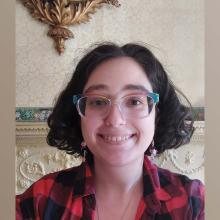 Engraving of a man sitting in a steam box, May 1869. Source: Wellcome Images.
Engraving of a man sitting in a steam box, May 1869. Source: Wellcome Images.
Have you ever wondered what non-surgical medicine was like in the nineteenth century? You may already be aware that the until the first use of ether in 1846, surgery was routinely performed without anesthesia—sounds pretty horrific! I decided that I wanted to learn more about how various ailments could have been treated in this era without anything quite so traumatic as surgery.
In my research into alternative nineteenth-century medicine, I came across a book from 1834 titled The Ladies Medical Oracle, or Mrs. Mott’s advice to young females, wives, and mothers by Elizabeth Mott. Mrs. Mott discusses a treatment she calls the Patent Champoo and Medicated Bath, which her husband, Dr. Richard D. Mott, officially patented in 1833. The couple claimed they could cure diseases “hitherto thought incurable” using this contraption.
Similar to the image of the steam box above, a patient using the Medicated Champoo Bath would sit inside an enclosed space—in this case, a canvas tent. Water was heated in a metal container, and the steam was piped into a second container which was filled with the Motts’ proprietary blend of medicinal herbs and vegetables, then piped into the tent for the patient to breathe. According to the Motts, this method of treatment, in conjunction with their remedies, rest, and other preventative measures, could cure almost any disease.
Throughout her book, Mrs. Mott notes that the best method to cure disease is to start with an understanding of the disease and how the human body works, and add a little ingenuity. Most of her advice involves maintaining a comfortable temperature (she is constantly warning against moving from a warm bed into a cold bath, or washing with warm water during cold weather), performing low-impact exercises, and doing what can be done to avoid disease. If you do fall ill, The Oracle offers a plethora of holistic remedies: for example, when afflicted with a cold, Mrs. Mott recommends using her Medicated Baths, taking Life Elixir (a mix of herbs with medicinal properties), and resting comfortably.
Although we often hear about the more invasive and painful medical procedures of the nineteenth century, not all physicians of the era practiced this type of medicine. There were alternative options which focused on natural cures. Holistic medicine, such as using herbal remedies, turning to an all-natural or organic diet, and engaging in low-impact exercises, might seem like a novel idea today, but practitioners like Mrs. and Dr. Mott were promoting this type of treatment and lifestyle as early as the 1830s!
Further Learning
External Database: Popular Medicine in America, 1800-1900 from AM Explorer
This unique collection showcases the development of 'popular' medicine in America during the nineteenth century, through an extensive range of material that was aimed at the general public rather than medical professionals. Explore an array of printed sources, including rare books, pamphlets, trade cards, and visually-rich advertising ephemera. Members of American Ancestors can access this collection from our partner organization.
Free Video: Janice P. Nimura with The Doctors Blackwell: How Two Pioneering Sisters Brought Medicine to Women—and Women to Medicine
This discussion about women in medicine reveals the remarkable lives of Elizabeth and Emily Blackwell, who were two of the first American women to earn medical degrees. Janice P. Nimura’s richly researched biography celebrates and captures the complexity of these pioneers.
Free Video: Pam Fessler with Carville's Cure: Leprosy, Stigma, And The Fight For Justice
Hear from acclaimed broadcast journalist Pam Fessler as she discusses her book on the largely forgotten history of leprosy in the United States, and the “leprosarium” established in 1894 in the town of Carville, Louisiana.
Notes
1 Elizabeth Mott, The Ladies’ Medical Oracle: Or, Mrs. Mott’s Advice to Young Females, Wives, and Mothers (Samuel N. Dickinston, 1834), 17-18.
2 "Mrs. Mott" Newspapers.com. Boston Post, November 2, 1840. https://www.newspapers.com/article/boston-post-mrs-mott/134235815/.
3 "Patent for the Medicated and Champoo Baths" Newspapers.com. Boston Post, October 14, 1834. https://www.newspapers.com/article/boston-post-patent-for-the-medicated-and/134233842/.
Share this:

About Beck Green
Beck is a Researcher at American Ancestors. They hold both a B.A. in Public History and a M.A. in Preservation Studies with a concentration in Museum Practices. Their interest in genealogy grew from a fascination with the human aspect of history; the ways in which museum collections are more than just objects on display, they are the result of people connecting with the world around them.View all posts by Beck Green →